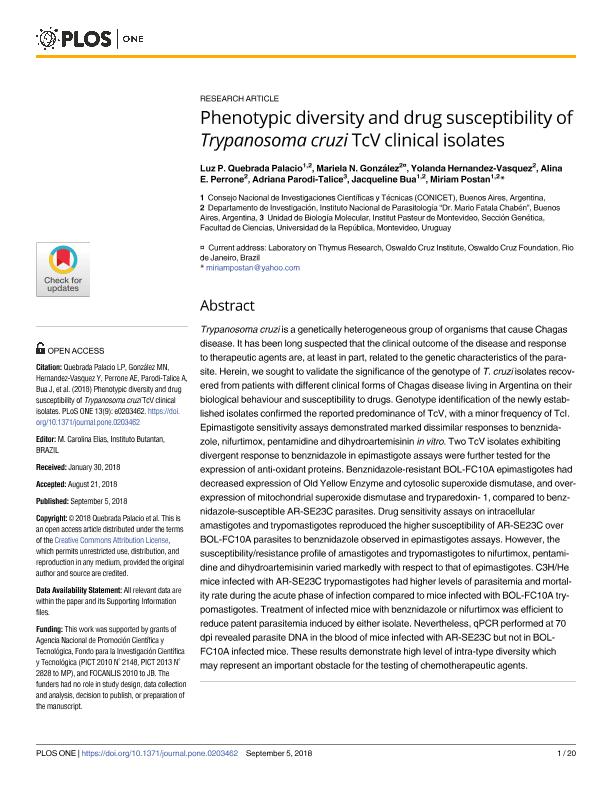Artículo
Phenotypic diversity and drug susceptibility of Trypanosoma cruzi TcV clinical isolates
Quebrada Palacio, Luz Piedad ; González, Mariela Natacha
; González, Mariela Natacha ; Hernandez Vasquez, Yolanda Maria; Perrone, Alina Elizabeth
; Hernandez Vasquez, Yolanda Maria; Perrone, Alina Elizabeth ; Parodi Talice, Adriana; Bua, Jacqueline Elena
; Parodi Talice, Adriana; Bua, Jacqueline Elena ; Postan, Miriam
; Postan, Miriam
 ; González, Mariela Natacha
; González, Mariela Natacha ; Hernandez Vasquez, Yolanda Maria; Perrone, Alina Elizabeth
; Hernandez Vasquez, Yolanda Maria; Perrone, Alina Elizabeth ; Parodi Talice, Adriana; Bua, Jacqueline Elena
; Parodi Talice, Adriana; Bua, Jacqueline Elena ; Postan, Miriam
; Postan, Miriam
Fecha de publicación:
09/2018
Editorial:
Public Library of Science
Revista:
Plos One
ISSN:
1932-6203
Idioma:
Inglés
Tipo de recurso:
Artículo publicado
Clasificación temática:
Resumen
Trypanosoma cruzi is a genetically heterogeneous group of organisms that cause Chagas disease. It has been long suspected that the clinical outcome of the disease and response to therapeutic agents are, at least in part, related to the genetic characteristics of the parasite. Herein, we sought to validate the significance of the genotype of T. cruzi isolates recovered from patients with different clinical forms of Chagas disease living in Argentina on their biological behaviour and susceptibility to drugs. Genotype identification of the newly established isolates confirmed the reported predominance of TcV, with a minor frequency of TcI. Epimastigote sensitivity assays demonstrated marked dissimilar responses to benznidazole, nifurtimox, pentamidine and dihydroartemisinin in vitro. Two TcV isolates exhibiting divergent response to benznidazole in epimastigote assays were further tested for the expression of anti-oxidant proteins. Benznidazole-resistant BOL-FC10A epimastigotes had decreased expression of Old Yellow Enzyme and cytosolic superoxide dismutase, and over-expression of mitochondrial superoxide dismutase and tryparedoxin- 1, compared to benznidazole-susceptible AR-SE23C parasites. Drug sensitivity assays on intracellular amastigotes and trypomastigotes reproduced the higher susceptibility of AR-SE23C over BOL-FC10A parasites to benznidazole observed in epimastigotes assays. However, the susceptibility/resistance profile of amastigotes and trypomastigotes to nifurtimox, pentamidine and dihydroartemisinin varied markedly with respect to that of epimastigotes. C3H/He mice infected with AR-SE23C trypomastigotes had higher levels of parasitemia and mortality rate during the acute phase of infection compared to mice infected with BOL-FC10A trypomastigotes. Treatment of infected mice with benznidazole or nifurtimox was efficient to reduce patent parasitemia induced by either isolate. Nevertheless, qPCR performed at 70 dpi revealed parasite DNA in the blood of mice infected with AR-SE23C but not in BOL-FC10A infected mice. These results demonstrate high level of intra-type diversity which may represent an important obstacle for the testing of chemotherapeutic agents.
Palabras clave:
Trypanosoma cruzi
,
Chagas disease
,
Phenotypic diversity
Archivos asociados
Licencia
Identificadores
Colecciones
Articulos(SEDE CENTRAL)
Articulos de SEDE CENTRAL
Articulos de SEDE CENTRAL
Citación
Quebrada Palacio, Luz Piedad; González, Mariela Natacha; Hernandez Vasquez, Yolanda Maria; Perrone, Alina Elizabeth; Parodi Talice, Adriana; et al.; Phenotypic diversity and drug susceptibility of Trypanosoma cruzi TcV clinical isolates; Public Library of Science; Plos One; 13; 9; 9-2018; 1-20
Compartir
Altmétricas



